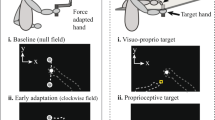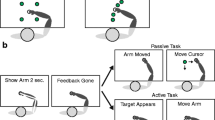Abstract
Neural circuits connecting the cerebellum with the cerebral cortex are important for both motor and cognitive functions. Therefore, assessment of cerebellar function is clinically important for patients with various motor and cognitive dysfunctions. Cerebellum-dependent motor learning has been studied using various tasks. The most widely used tasks are visuomotor adaptation tasks, in which subjects are required to make movements in two dimensions. Studies using simpler tasks of one-dimensional movement, which are easier for patients with motor problems to perform, have suggested that anticipatory responses in these tasks are useful to evaluate cerebellum-dependent motor control or motor learning. In this study, we examined whether the motor learning process can be evaluated in a simple loading task. Using space interface device for artificial reality (SPIDAR), a constant downward force was loaded to subjects’ hands in a predictable condition, and the vertical movement of the hand was recorded. The hand deflection from the initial position was displayed on a screen for visual feedback information. We examined effects of repeated loading task training (90 times) on hand movements, by analyzing a small upward movement just before loading (anticipatory response) and a large downward movement after loading in each trial. We found that the repeated training lowered the time constant of upward movement and reduced the amplitude and time-to-peak of downward movement. These training effects were maintained into the next day. Furthermore, we found that loading task training with eyes closed was also effective, which indicates that proprioceptive information is enough for improvement of performance.







Similar content being viewed by others
References
Bastian AJ (2006) Learning to predict the future: the cerebellum adapts feedforward movement control. Curr Opin Neurobiol 16:645–649. https://doi.org/10.1016/j.conb.2006.08.016
Bernard JA, Mittal VA (2014) Cerebellar-motor dysfunction in schizophrenia and psychosis-risk: the importance of regional cerebellar analysis approaches. Front Psychiatry 5:160. https://doi.org/10.3389/fpsyt.2014.00160
Cluff T, Scott SH (2013) Rapid feedback responses correlate with reach adaptation and properties of novel upper limb loads. J Neurosci 33:15903–15914. https://doi.org/10.1523/JNEUROSCI.0263-13.2013
Cohen J (1988) Statistical Power Analysis for the Behavioral Sciences. Lawrence Erlbaum Associates, New Jersey, United states
D’Mello AM, Stoodley CJ (2015) Cerebro-cerebellar circuits in autism spectrum disorder. Front Neurosci 9:408. https://doi.org/10.3389/fnins.2015.00408
Dhawale AK, Smith MA, Ölveczky BP (2017) The role of variability in motor learning. Annu Rev Neurosci 40:479–498. https://doi.org/10.1146/annurev-neuro-072116-031548
Diedrichsen J, Verstynen T, Lehman SL, Ivry RB (2005) Cerebellar involvement in anticipating the consequences of self-produced actions during bimanual movements. J Neurophysiol 93:801–812. https://doi.org/10.1152/jn.00662.2004
Doya K (2000) Complementary roles of basal ganglia and cerebellum in learning and motor control. Curr Opin Neurobiol 10:732–739. https://doi.org/10.1016/s0959-4388(00)00153-7
Hadjiosif AM, Krakauer JW, Haith AM (2021) Did we get sensorimotor adaptation wrong? Implicit adaptation as direct policy updating rather than forward-model-based learning. J Neurosci 41:2747–2761. https://doi.org/10.1523/JNEUROSCI.2125-20.2021
Hashimoto Y, Honda T, Matsumura K et al (2015) Quantitative evaluation of human cerebellum-dependent motor learning through prism adaptation of hand-reaching movement. PLoS ONE 10:e0119376. https://doi.org/10.1371/journal.pone.0119376
Ikegami T, Hirashima M, Taga G, Nozaki D (2010) Asymmetric transfer of visuomotor learning between discrete and rhythmic movements. J Neurosci 30:4515–4521. https://doi.org/10.1523/JNEUROSCI.3066-09.2010
Imamizu H, Miyauchi S, Tamada T et al (2000) Human cerebellar activity reflecting an acquired internal model of a new tool. Nature 403:192–195. https://doi.org/10.1038/35003194
Ito M (2000) Mechanisms of motor learning in the cerebellum. Brain Res 886:237–245. https://doi.org/10.1016/s0006-8993(00)03142-5
Ito M (2008) Control of mental activities by internal models in the cerebellum. Nat Rev Neurosci 9:304–313. https://doi.org/10.1038/nrn2332
Kambara H, Shin D, Kawase T, Yoshimura N, Akahane K, Sato M, Koike Y (2013) The effect of temporal perception on weight perception. Front Psychol 4:40. https://doi.org/10.3389/fpsyg.2013.00040
Kasuga S, Telgen S, Ushiba J, Nozaki D, Diedrichsen J (2015) Learning feedback and feedforward control in a mirror-reversed visual environment. J Neurophysiol 114:2187–2193. https://doi.org/10.1152/jn.00096.2015
Kawase T, Ohishi K, Yoneyama K, Kambara H, Koike Y (2012) Recalibration of time to contact. Robot Auton Syst 60:742–746. https://doi.org/10.1016/j.robot.2011.06.011
Kelly E, Escamilla CO, Tsai PT (2021) Cerebellar dysfunction in autism spectrum disorders: deriving mechanistic insights from an internal model framework. Neuroscience 462:274–287. https://doi.org/10.1016/j.neuroscience.2020.11.012
Kikuchi Y, Yoneda M, Ohno-Shosaku T (2015) Impaired anticipatory hand movement during a loading task in patients with schizophrenia. J Tsuruma Health Sci Soc 39:113–123
Koike Y, Kim J, Shin D (2006) Role of stiffness in weight perception. Jpn Psychol Res 48:174–187
Lang CE, Bastian AJ (1999) Cerebellar subjects show impaired adaptation of anticipatory EMG during catching. J Neurophysiol 82:2108–2119. https://doi.org/10.1152/jn.1999.82.5.2108
Lang CE, Bastian AJ (2001) Additional somatosensory information does not improve cerebellar adaptation during catching. Clin Neurophysiol 112:895–907. https://doi.org/10.1016/s1388-2457(01)00518-1
Li N, Chen G, Xie Y, Chen Z (2021) Aging effect on visuomotor adaptation: mediated by cognitive decline. Front Aging Neurosci 13:742928. https://doi.org/10.3389/fnagi.2021.742928
Moberget T, Ivry RB (2019) Prediction, psychosis, and the cerebellum. Biol Psychiatry Cogn Neurosci Neuroimag 4:820–831. https://doi.org/10.1016/j.bpsc.2019.06.001
Mothersill O, Knee-Zaska C, Donohoe G (2016) Emotion and theory of mind in schizophrenia-investigating the role of the cerebellum. Cerebellum 15:357–368. https://doi.org/10.1007/s12311-015-0696-2
Nowak DA, Hermsdörfer J, Rost K, Timmann D, Topka H (2004) Predictive and reactive finger force control during catching in cerebellar degeneration. Cerebellum 3:227–235. https://doi.org/10.1080/14734220410019057
Peterburs J, Desmond JE (2016) The role of the human cerebellum in performance monitoring. Curr Opin Neurobiol 40:38–44. https://doi.org/10.1016/j.conb.2016.06.011
Popa LS, Streng ML, Hewitt AL, Ebner TJ (2016) The errors of our ways: understanding error representations in cerebellar-dependent motor learning. Cerebellum 15:93–103. https://doi.org/10.1007/s12311-015-0685-5
Shadmehr R, Moussavi ZM (2000) Spatial generalization from learning dynamics of reaching movements. J Neurosci 20:7807–7815
Spampinato D, Celnik P (2021) Multiple motor learning processes in humans: defining their neurophysiological bases. Neuroscientist 27:246–267. https://doi.org/10.1177/1073858420939552
Su LD, Xu FX, Wang XT, Cai XY, Shen Y (2021) Cerebellar dysfunction, cerebro-cerebellar connectivity and autism spectrum disorders. Neuroscience 462:320–327. https://doi.org/10.1016/j.neuroscience.2020.05.028
Telgen S, Parvin D, Diedrichsen J (2014) Mirror reversal and visual rotation are learned and consolidated via separate mechanisms: recalibrating or learning de novo? J Neurosci 34:13768–13779. https://doi.org/10.1523/JNEUROSCI.5306-13.2014
Tzvi E, Loens S, Donchin O (2022) Mini-review: The role of the cerebellum in visuomotor adaptation. Cerebellum 21:306–313. https://doi.org/10.1007/s12311-021-01281-4
Wagner MJ, Luo L (2020) Neocortex-Cerebellum circuits for cognitive processing. Trends Neurosci 43:42–54. https://doi.org/10.1016/j.tins.2019.11.002
Werner S, Bock O (2010) Mechanisms for visuomotor adaptation to left-right reversed vision. Hum Mov Sci 29:172–178. https://doi.org/10.1016/j.humov.2010.02.004
Wong AL, Marvel CL, Taylor JA, Krakauer JW (2019) Can patients with cerebellar disease switch learning mechanisms to reduce their adaptation deficits? Brain 142:662–673. https://doi.org/10.1093/brain/awy334
Funding
This work was supported by Grants-in-Aid for Scientific Research (19K19790) from the Japan Society for the Promotion of Science.
Author information
Authors and Affiliations
Contributions
TO: investigation, formal analysis, writing—original draft, supervision. YK: investigation, formal analysis, supervision. IA: investigation. TOS: writing—review & editing. YK: methodology, software. MY: conceptualization, supervision, funding acquisition.
Corresponding author
Ethics declarations
Conflict of interest
On behalf of all authors, the corresponding author states that there is no conflict of interest.
Data availability
The data sets of the current study are available from the corresponding author on reasonable request.
Additional information
Communicated by Winston D Byblow.
Publisher's Note
Springer Nature remains neutral with regard to jurisdictional claims in published maps and institutional affiliations.
Rights and permissions
Springer Nature or its licensor (e.g. a society or other partner) holds exclusive rights to this article under a publishing agreement with the author(s) or other rightsholder(s); author self-archiving of the accepted manuscript version of this article is solely governed by the terms of such publishing agreement and applicable law.
About this article
Cite this article
Ota, T., Kikuchi, Y., Amiya, I. et al. Evaluation of motor learning in predictable loading task using a force sense presentation device. Exp Brain Res 240, 3305–3314 (2022). https://doi.org/10.1007/s00221-022-06500-w
Received:
Accepted:
Published:
Issue Date:
DOI: https://doi.org/10.1007/s00221-022-06500-w




